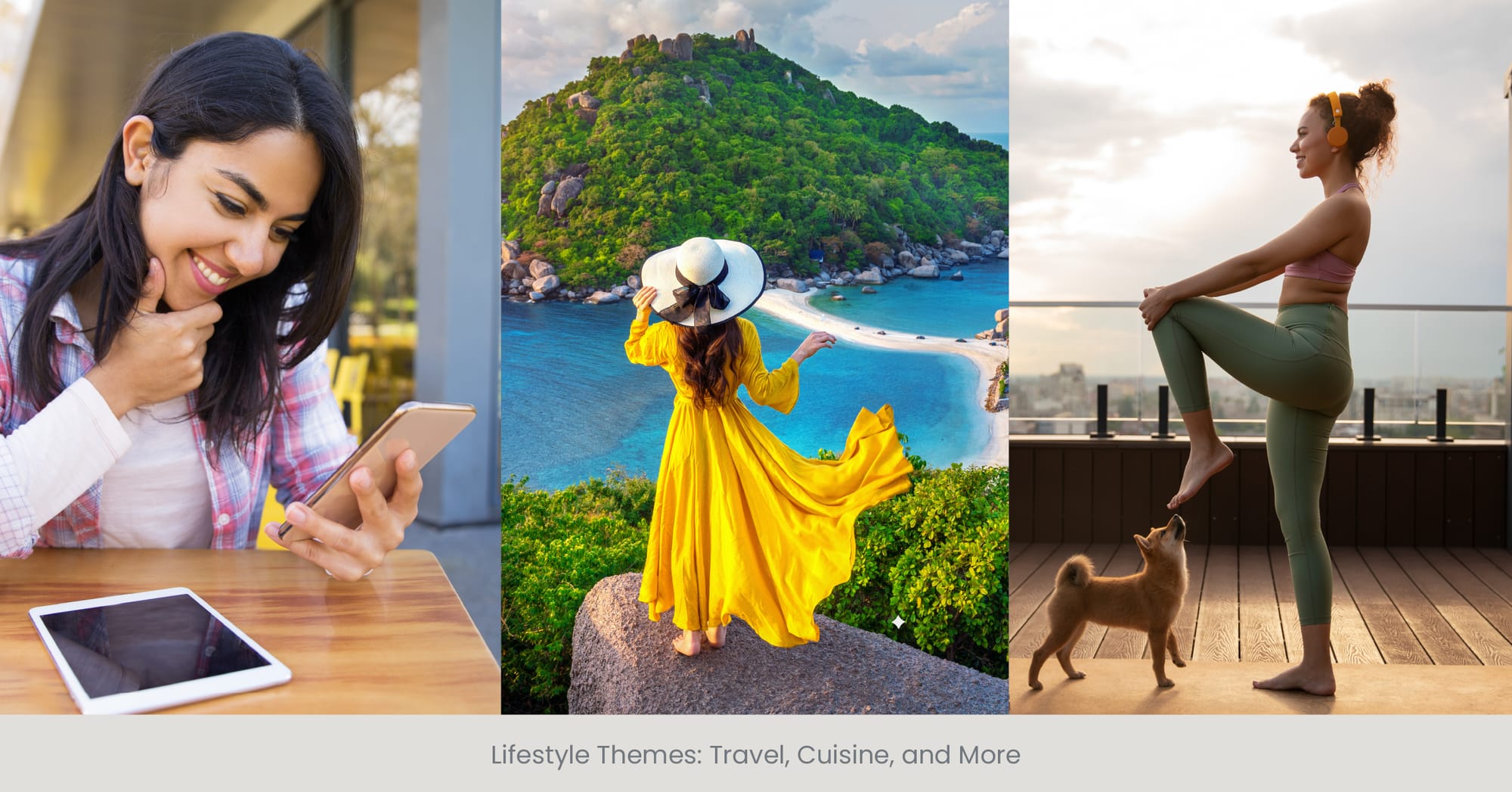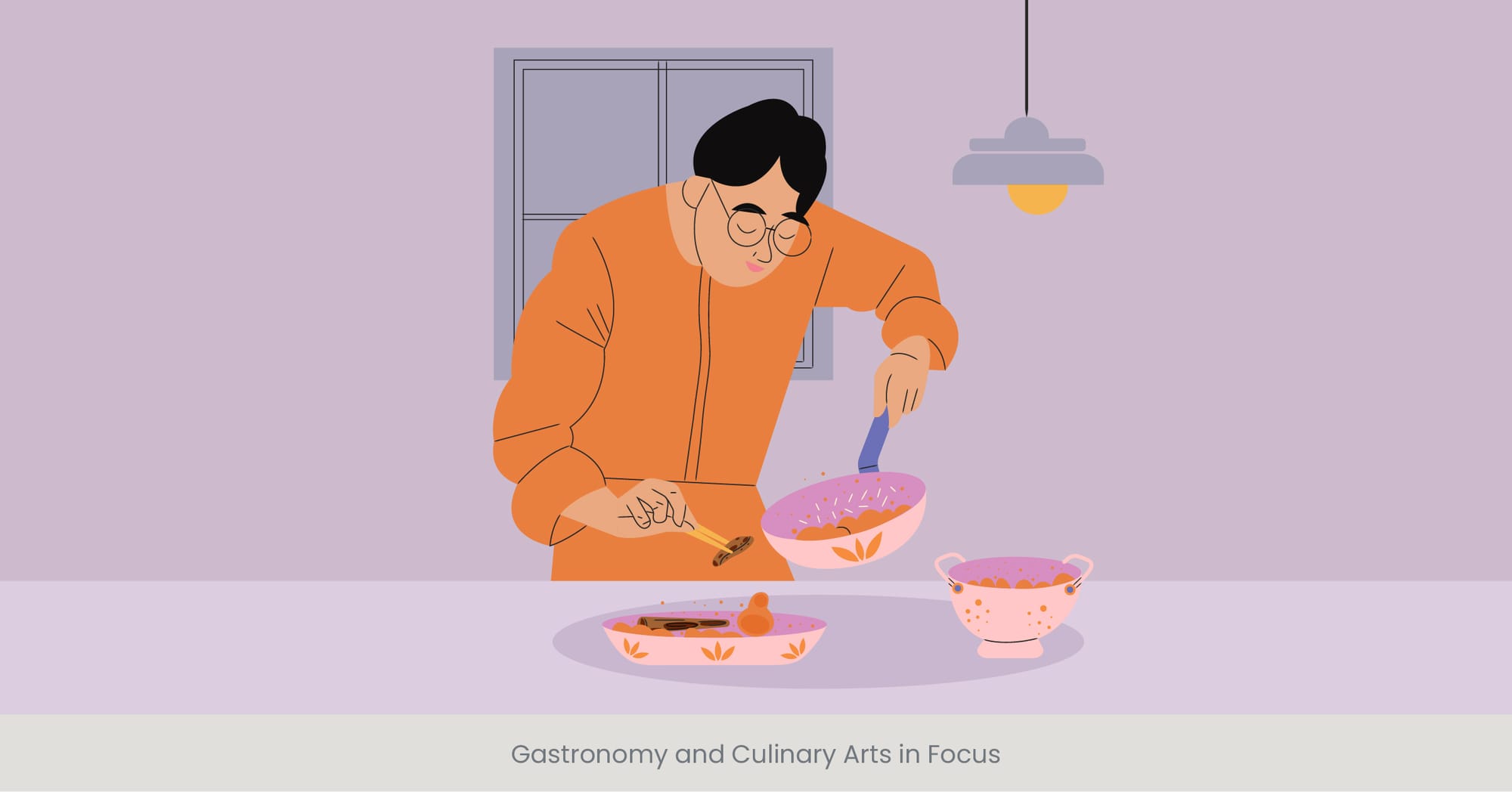Influencing Trends and Lifestyle

Lifestyle Themes: Travel, Cuisine, and More

Engaging the Wanderlust: The Essence of Travel and Cuisine
Travel and cuisine are more than mere interests or hobbies; they are a lifestyle. The amalgamation of these elements represents a quest for exploration, not just of the world but of the flavors and traditions that define different cultures. This sub-topic delves into the rich tapestry of experiences that travel and cuisine offer, illustrating how they influence and are influenced by the lifestyles of individuals across the globe. It's a celebration of the senses, inviting readers to embark on a journey that transcends physical borders, offering a glimpse into the diverse ways of life that enrich our world.
Culinary Journeys and Destination Discoveries
The background of travel and cuisine as lifestyle themes is deeply rooted in the human desire for discovery and connection. Historically, explorers set sail not just in search of new lands but also of spices and ingredients, thereby weaving the first threads of global cuisine. Today, this tradition continues as people seek to understand and appreciate cultures through their culinary practices. From the bustling street markets of Bangkok to the vineyards of Tuscany, each destination offers a unique palette of flavors, cooking techniques, and dining customs, serving as a testament to the diversity and richness of cultural heritage.
A World of Flavors at Your Fingertips
Real-world examples abound when it comes to travel and cuisine shaping lifestyles. Cooking classes in Paris, wine tasting in Napa Valley, or street food tours in Ho Chi Minh City not only satisfy the palate but also offer insights into the heart of each culture. These experiences demonstrate how cuisine can act as a bridge between cultures, fostering a deeper understanding and appreciation. Additionally, the rise of travel influencers and food bloggers has played a significant role in highlighting unique culinary and travel experiences, making them accessible to a global audience and inspiring a new generation of travelers and food enthusiasts.
Shaping Interior Design Trends

The Canvas of Our Lives: Interior Design as Lifestyle Expression
Interior design transcends the mere aesthetics of space, embodying a reflection of personal identity and lifestyle. This sub-topic ventures into the heart of how contemporary trends in the art of interior design are not just about creating visually appealing spaces but are deeply intertwined with the way individuals live, work, and find comfort in their personal environments. From minimalist design approaches that prioritize simplicity and functionality to eclectic styles that celebrate diversity and personal history, interior design trends offer a palette through which personal stories and lifestyles are narrated.
Historical Influences and Modern Adaptations
The evolution of interior design reflects the changing dynamics of society, technology, and environmental consciousness. Historically, design trends have been influenced by cultural shifts, technological advancements, and artistic movements. For instance, the Art Deco movement of the early 20th century, with its emphasis on bold geometric patterns and luxurious materials, mirrored the societal optimism of the time. Today, modern interior design trends often focus on sustainability, technological integration, and the fusion of indoor and outdoor spaces, highlighting the changing priorities and lifestyles of contemporary society. This background enriches our understanding of interior design not merely as a form of decoration but as a living, evolving expression of human culture and environmental awareness.
Reflecting Modern Lifestyles Through Design
Practical examples of how current interior design trends are shaped by and shape our lifestyles are evident in the popularity of open-plan living spaces, smart homes, and sustainable materials. The preference for open-plan designs reflects a desire for more social, flexible living spaces that accommodate work, entertainment, and relaxation. Smart homes, with their emphasis on automation and efficiency, cater to a lifestyle that values convenience and technology. Moreover, the increasing use of sustainable and recycled materials speaks to a growing environmental consciousness. These trends, among others, illustrate the dynamic interplay between interior design and contemporary lifestyles, where each influences and informs the other.
Influencing Fashion and Beauty Standards

Redefining Elegance: The Evolution of Fashion and Beauty
Fashion and beauty standards are not static; they are dynamic reflections of cultural shifts, societal values, and technological advancements. This sub-topic explores the transformative journey of fashion and beauty norms, highlighting how they've evolved to embrace diversity, individuality, and sustainability. As mirrors of the times, fashion and beauty trends offer insight into societal changes, pushing boundaries and challenging conventional notions of beauty and style. From haute couture runways to street style fashion, the landscape is continually reshaped by creative minds that dare to redefine elegance for the modern era.
The Threads of History and Contemporary Fabric
The historical backdrop of fashion and beauty reveals a tapestry woven with the threads of social movements, technological innovations, and artistic expressions. From the opulent dresses of the Renaissance that signaled wealth and status to the minimalist trends of the 20th century reflecting shifting gender norms, each period presents a unique narrative of societal values. In recent years, the focus of designs has shifted towards inclusivity, eco-consciousness, and ethical production, signifying a collective move towards more responsible consumption. Understanding the historical context enriches our appreciation of current trends, highlighting the cyclical nature of fashion and beauty standards.
Current Catwalks and Cultural Dialogues
Today, fashion and beauty are celebrated as platforms for self-expression and cultural dialogue. Designers and brands leverage their influence to address global issues, promote diversity, and foster a sense of community among consumers. Examples include the use of sustainable materials in collections, representation of diverse body types and ethnicities in fashion shows and advertising, and collaborations with artisans from around the world. These practices not only highlight the industry's adaptability and responsiveness to contemporary concerns but also its role in shaping a more inclusive and conscious society.
Fashion Coffee Table Books on Health and Wellness

A Holistic Approach to Well-being
In recent years, there has been a significant shift towards embracing health and wellness not just as a trend but as a lifestyle. This sub-topic delves into the growing prominence of coffee table book dedicated to health and wellness, showcasing the holistic approach individuals are taking towards maintaining their physical, mental, and emotional well-being.
The Foundations of Wellness Literature
The genesis of health and wellness literature and art can be traced back to ancient texts and practices, evolving through the ages to adapt to contemporary understandings of health. Modern, coffee table book, book and art about health and wellness draw on this rich history, incorporating traditional practices like yoga and meditation with current wellness trends and scientific research. They provide a visually appealing and accessible way to explore various dimensions of health, from nutritional science to mental health strategies, offering readers a comprehensive guide to enhancing their quality of life.
Wellness Through the Pages: Examples and Trends
Real-world examples of how coffee table book influence and reflect health and wellness trends abound. Books featuring serene landscapes and tranquil interiors promote mental well-being, while those focusing on fitness and nutrition offer practical advice for maintaining physical health. Title such titles as "The Art of Well-being" or "Mind, Body, Home" exemplify the genre, combining stunning photography with insightful content to motivate and inspire readers.
Adventure and Exploration Through Pages

Unveiling the World Through Words and Images
Adventure and exploration have always been intrinsic to the human spirit, driving us to discover what lies beyond our known world. This sub-topic celebrates the role of coffee table books in bringing the thrill of adventure and the beauty of exploration into our homes. These coffee table books themselves, often rich with awe-inspiring photography and compelling narratives, serve as windows to the remote, the wild, and the extraordinary. They encapsulate the essence of discovery, from the deepest oceans to the highest peaks, offering readers a chance to journey through the pages to places they've only dreamed of visiting.
Historical Expeditions and Modern-Day Journeys
The lure of the unknown has propelled adventurers and explorers across centuries to embark on journeys that have shaped our understanding of the world. Coffee table books about these expeditions provide a fascinating glimpse into both the past and present of exploration. They chronicle the daring feats of historical figures, the challenges they faced, and the impact of their discoveries on our world view. Contemporary coffee table books also showcase modern explorers who push the boundaries of human endurance and technology, revealing the planet's last uncharted territories and the wonders they hold.
Stories of Resilience, Discovery, and Wonder
Highlighting real-world examples, coffee table books about adventure and exploration offer narratives that are as diverse as the landscapes they cover. Books like "Atlas of Remote Islands" or "The Mountains of My Life" not only present breathtaking visuals but also share the personal stories of resilience, discovery, and wonder that define the spirit of exploration. They bring to life the excitement of archaeological digs, the challenge of polar expeditions, and the sheer joy of discovering cultures vastly different from our own. These stories inspire readers to look beyond their horizons and encourage a sense of adventure in their lives.
Gastronomy and Culinary Arts in Focus

The Art and Science of Culinary Perfection
Gastronomy and culinary arts represent a fascinating blend of tradition, innovation, and craftsmanship that transcends cultural boundaries, offering a universal language of flavor and creativity. This sub-topic explores the rich world of gastronomy as an art form and of art as a science, highlighting the meticulous techniques, historical influences, and evolving trends that shape our dining experiences. Culinary arts are not just about sustenance but about creating experiences that engage the senses, evoke emotions, and bring people together, showcasing the chef's ability to transform simple ingredients into masterpieces of taste and presentation.
From Ancient Feasts to Modern Tables
The history of gastronomy is as old as civilization itself, with each era bringing its own innovations to the culinary world. Ancient culinary practices were deeply intertwined with cultural and religious rituals, while the Middle Ages and Renaissance saw the emergence of sophisticated dining customs and the refinement of ingredients and techniques. The modern culinary arts have been shaped by globalization, sustainability concerns, and technological advancements, leading to a rich diversity of culinary styles and a renewed focus on local and seasonal produce. This historical journey underscores the dynamic nature of culinary arts, constantly evolving while staying rooted in tradition.
Celebrating Culinary Genius: Chefs and Trends
The current landscape of gastronomy is marked by a celebration of culinary diversity and innovation, with chefs around the world pushing the boundaries of traditional cuisine to create new tastes and experiences. From farm-to-table movements that emphasize local sourcing and sustainability to the fusion of seemingly disparate culinary traditions, today's culinary trends reflect a globalized world's creativity and interconnectedness. Celebrated chefs, such as Massimo Bottura and Dominique Crenn, have become household names, not just for their exceptional skills but for their commitment to using gastronomy as a means for social change and environmental advocacy.
The Interplay Between Culture and Society

Weaving the Social Fabric: Culture's Influence on Society
The relationship between culture and society is a dynamic interplay that shapes our values, behaviors, and collective identity. This sub-topic delves into how cultural expressions, from the arts and literature to customs and traditions, serve as both a mirror and a mold for societal values, influencing and being influenced by the social fabric. Culture encapsulates the shared experiences and diversity of communities, acting as a vehicle for communication, understanding, and unity across differences. It is through cultural practices that societies articulate their histories, aspirations, and norms, making culture an essential element in the development and evolution of social structures.
Historical Contexts and Contemporary Dynamics
The historical context of culture's impact on society reveals a rich tapestry of influences that have shaped human civilization. From ancient rituals and mythologies that defined early societal structures to the Renaissance's flowering of arts and science, culture has been a driving force in societal evolution. In contemporary times, this dynamic continues with the global exchange of cultural practices fostering greater understanding and cooperation between societies. Moreover, the digital age has revolutionized how cultures are expressed and disseminated, breaking down geographical barriers and creating a global village of shared experiences and values.
Real-World Manifestations: Culture in Action
In today's world, the interplay between culture and society can be observed in the global response to social issues, the blending of traditions in multicultural communities, and the role of digital media in shaping public discourse. Cultural festivals, music, and film are powerful tools for raising awareness about social causes, while traditional and modern artistic expressions reflect and challenge societal norms. Examples such as the global popularity of K-pop or the resurgence of indigenous crafts worldwide illustrate how culture transcends borders, influencing fashion, language, and even policy on a global scale.
Environmental Awareness and Conservation

Nurturing the Planet: The Rise of Environmental Consciousness
In the face of escalating environmental challenges, there has been a significant shift towards greater awareness and action for conservation. This sub-topic explores the growing movement of environmental consciousness that spans the globe, emphasizing the urgent need for sustainable practices to protect the earth's natural resources and biodiversity. Environmental awareness is not just about recognizing the problems but actively seeking solutions through conservation efforts, sustainable living, and policy change. It's a testament to the collective responsibility felt by individuals, communities, and nations towards nurturing and preserving the planet for future generations.
Roots of the Green Movement: A Historical Perspective
The environmental movement has deep roots, tracing back to the conservation efforts of the late 19th and early 20th centuries. Early advocates for nature conservation and wildlife protection laid the groundwork for the modern environmentalism that emerged in the 1960s and 1970s, following Rachel Carson's seminal work "Silent Spring." This period marked a significant shift in public consciousness, leading to the establishment of Earth Day, the creation of environmental protection agencies, and the passage of landmark legislation aimed at preserving air, water, and endangered species. Understanding this historical evolution is crucial in appreciating the depth and breadth of contemporary environmental awareness and the ongoing fight for a sustainable planet.
Making a Difference: Conservation in Action
Today's environmental conservation efforts are as varied as the challenges they aim to address, ranging from local community clean-ups to international agreements on climate change. Innovative solutions like reforestation projects, wildlife corridors, and sustainable agriculture practices showcase the practical application of environmental awareness. Real-world examples include the global movement to reduce plastic use, the expansion of protected marine areas, and grassroots campaigns for renewable energy. These actions underscore the role that informed, engaged citizens play in driving environmental change, demonstrating that collective action can lead to meaningful conservation outcomes.
Luxury Brands and Their Stories

The Allure of Luxury: Crafting Desire and Distinction
Luxury brands occupy a unique position in the cultural and economic landscape, representing not just the pinnacle of craftsmanship and design but also a narrative of exclusivity, heritage, and innovation. This sub-topic delves into the world of luxury brands, exploring how they craft stories that resonate with desires for distinction, beauty, and a connection to a storied history. Luxury brands do more than sell products; they sell dreams and identities, imbued with values and traditions that have often been cultivated over centuries. These brands stand at the intersection of art and commerce, where every item tells a story of excellence and every brand embodies a legacy of luxury.
From Couturiers to Connoisseurs: The Evolution of Luxury
The history of luxury brands is a fascinating journey through time, where craftsmanship, exclusivity, and prestige have been the hallmarks of luxury since ancient civilizations. The modern luxury industry can trace its roots back to the European courts, where bespoke craftsmanship was highly valued. Over the centuries, these artisanal practices evolved into the luxury brands we recognize today, with a focus on fashion, jewelry, and haute couture. The 20th and 21st centuries have seen luxury brands adapt to changing societal norms and consumer behaviors, embracing technology and sustainability while maintaining their core values of quality and exclusivity.
Emblematic Luxury: Today's Icons and Innovations
In the contemporary scene, luxury brands continue to set trends and influence global fashion and lifestyle. Through a combination of traditional craftsmanship and innovative designs, they maintain their status at the forefront of the luxury market. Iconic brands like Chanel, Louis Vuitton, and Rolex have become symbols of sophistication and status, each with its own story of origin, evolution, and iconic products that have left indelible marks on the industry. Moreover, these brands are increasingly engaging with issues of sustainability and ethics, reflecting a commitment to not just craftsmanship and exclusivity but also responsibility and forward-thinking.
Chronicles of Elegance: The Role of Literature and Media
The narratives of luxury brands are further enriched and disseminated through literature, media, and especially through fashion coffee table books, dedicated to titles, to fashion and luxury. These fashion coffee table books serve as both historical records and sources of inspiration, offering insight into the brands' storied pasts, their cultural impact, and the visionary individuals behind them. Titles with titles such as titles such "The Little Book of Chanel" or titles such "Louis Vuitton: The Birth of Modern Luxury" provide enthusiasts and connoisseurs alike with a deeper understanding of what lies behind the label, including the artistry, the heritage, and the innovation. Through stunning photography and compelling storytelling, titles in these publications celebrate the legacy and ongoing evolution of luxury brands, connecting them with a wider audience of admirers and aspiring collectors.
FAQs
How do interior design trends reflect current lifestyles?
Interior design trends often reflect the values and priorities of the current society, such as sustainability in design, technological integration, and personal well-being. For example, the rise of home office spaces and smart homes mirrors the increasing importance of remote work and efficiency, while the popularity of natural materials and plants indicates a growing awareness of environmental issues and mental health.
What role do luxury brands play in shaping consumer culture?
Luxury brands play a significant role in shaping consumer culture by setting standards of quality, exclusivity, and prestige. They influence fashion and lifestyle trends, drive innovation, and embody the aspirational desires of consumers, often reflecting broader societal values and shifts.
How do environmental awareness and conservation efforts impact lifestyle trends?
Environmental awareness and conservation efforts have significantly impacted lifestyle trends, leading to a shift towards sustainable living practices. This includes the adoption of eco-friendly products, sustainable fashion, design and a preference for brands and businesses that prioritize environmental responsibility.
What makes gastronomy and culinary arts significant to culture?
Gastronomy and culinary arts are significant to culture as they represent the essence of a society's traditions, history, and values through food. They foster a sense of identity and community, provide insights into cultural practices, and serve as a medium for cultural exchange and understanding.
Why is adventure and exploration important for personal growth?
Adventure and exploration are important for personal growth as they challenge individuals to step out of their comfort zones, encounter new perspectives, and develop resilience and adaptability. These experiences enrich one's understanding of the world and oneself, promoting a sense of curiosity and openness.
How does the digital age affect cultural and societal norms?
The digital age has dramatically affected cultural and societal norms by facilitating instant communication, access to information, and global connectivity. It has reshaped social interactions, cultural consumption, and the dissemination of ideas, leading to more fluid and diverse expressions of identity and community.
What impact do cultural festivals have on promoting diversity and understanding?
Cultural festivals play a crucial role in promoting diversity and understanding by showcasing the traditions, music, food, and arts of different communities. They provide a platform for cultural exchange, fostering appreciation, respect, and dialogue among diverse groups.


%20(1).jpg)


